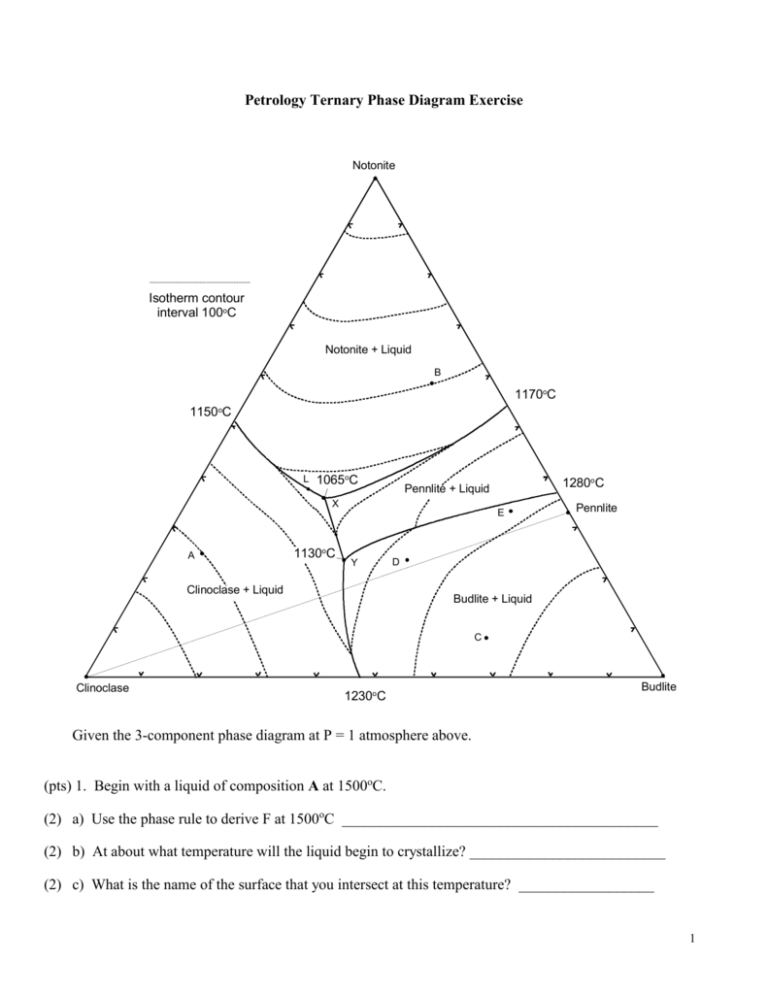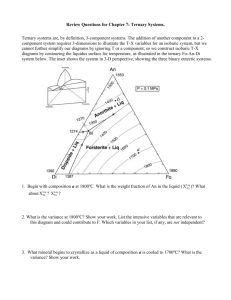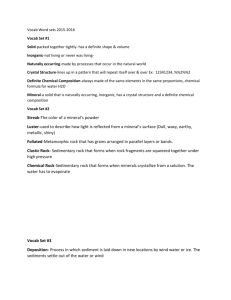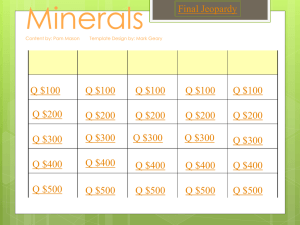Geology 345 -
advertisement

Petrology Ternary Phase Diagram Exercise Notonite Isotherm contour interval 100oC Notonite + Liquid B 1170oC 1150oC L 1065oC X A 1130oC 1280oC Pennlite + Liquid E Y Clinoclase + Liquid Pennlite D Budlite + Liquid C Clinoclase 1230oC Budlite Given the 3-component phase diagram at P = 1 atmosphere above. (pts) 1. Begin with a liquid of composition A at 1500oC. (2) a) Use the phase rule to derive F at 1500oC __________________________________________ (2) b) At about what temperature will the liquid begin to crystallize? __________________________ (2) c) What is the name of the surface that you intersect at this temperature? __________________ 1 (2) d) What mineral forms at this temperature? _________________________________ (2) e) Draw the liquid line of descent in red on the diagram until the next phase begins to crystallize. (2) f) At what temperature does the next phase begin to crystallize? ______________________ (2) g) What is the phase? _________________________ (2) h) What is the name of the curve that you intersect at this point? ____________________ (3) i) Use the phase rule to derive F at this point ____________________________ (3) j) As it would apply to this particular situation, what does the diagram and your value of F in part (i) tell you about how the compositions of each phase behaves with cooling? (i.e. which variables are likely to be independent, and which dependent, what can vary and what is fixed). (2) k) Draw the liquid line of descent in blue as it would continue for this liquid. (4) l) What is the ratio of Notonite and Clinoclase that is crystallizing from the liquid at the moment it reaches 1080oC? Show and label your construction lines (do it in sharp pencil). Sketch the lever below as well. (6) m) An instant before the liquid first reaches point x what are the proportions of the three coexisting phases at this temperature? Express the proportions as percentages, and show your work as in part (l). (2) n) What happens when the liquid first reaches point x? _________________________________ (2) o) What is the name of point x? ___________________________________ 2 (4) p) Determine F from the phase rule and interpret its meaning as it applies to the situation in (o). (2) q) At what temperature is crystallization complete? ______________________________ (5) r) What proportion of the crystallization of the original liquid occurred prior to 1065oC and what proportion occurred at 1065oC? Be specific. (5) s) What are the approximate proportions of the minerals in the final rock (as %)? Show your work. (2) t) How will fractional crystallization affect the liquid evolution curve? (3) u) How will fractional crystallization affect the mineral composition of the final rock? Be specific. 2. Heat a solid rock of composition B (and assume equilibrium melting). (2) a) At what temperature will the rock begin to melt. (3) b) Write the discontinuous reaction that takes place at this temperature. 3 (4) c) Which phase will be the first one consumed, and why? (2) d) Draw in green the path the liquid follows from the initial composition until it reaches about 1080oC. (2) e) Use the phase rule to determine F as the liquid follows the path that you have just drawn. (3) f) What is the continuous reaction that occurs along this path? ____________________________ (5) g) At what temperature will one of the reactants be consumed, and which one will it be? How can you determine this? Show and label any required construction lines on the diagram. (2) h) Draw the rest of the liquid path in orange until the system is completely liquid. At what temperature is melting complete? ________________________________ (6) 3. a) If perfect partial melting occurs for composition B, and each increment of melt created is removed, what will happen between 1065oC and 1100oC? Why? 4 (4) b) After leaving point x, what is the next melt composition, and at what temperature does it occur? (2) c) When does melting in the situation (b) cease? (5) d) What is the composition of the next melt increment, and at what temperature does if occur? 4. Begin with a melt of composition C. (2) a) At what temperature does the melt begin to crystallize? _________________________ (2) b) What is the first mineral to appear? ______________________________ (2) c) Draw the liquid evolution curve in yellow from the point of first crystallization until a new phase forms. (2) d) What is the next phase to form? _________________________ (2) e) At what temperature does it form? _______________________ (3) f) What is the continuous reaction that occurs along the curve toward point Y? ________________ (2) g) What happens when the liquid composition first reaches point Y? _______________________ (5) h) What is the discontinuous reaction that occurs at point Y? _____________________________ (2) i) What phase will be the first to be consumed (hint: remember the bulk composition). 5 (3) j) Will the liquid composition leave point Y? Y or Y not? 5. Cool a melt of composition D. (2) a) At what temperature will the first mineral crystallize? _________________________ (2) b) What mineral will it be? __________________________ (2) c) Draw the liquid line of descent in purple from this point until the next phase forms. (4) d) What is the next phase, and at about what temperature does it form? ____________________ (5) e) What will be the continuous reaction that occurs as the liquid evolves toward point Y, and how do you determine this? (2) f) What is the discontinuous reaction at point Y? ____________________________________ (2) g) Use the phase rule to derive F at this point. ________________________________________ (2) h) What will be the first phase to disappear at point Y? Why? (3) i) What will be the continuous reaction that occurs after the liquid leaves point Y? (2) j) What will happen when the liquid reaches point X? (2) k) At what temperature will the last of the liquid crystallize? (3) l) What will be the approximate proportions of the minerals in the final rock? 6 6. Begin with a liquid of composition E. (2) a) At what temperature will the first mineral crystallize? _________________________ (2) b) What mineral will form? __________________________ (2) c) Draw the liquid line of descent in light green from this point until the next phase forms. (4) d) What is the next phase, and at about what temperature does it form? ____________________ (2) e) What will be the continuous reaction that occurs as the liquid evolves toward point Y. (4) f) At what point will this liquid leave the peritectic curve? Show your construction lines. (2) g) What phase is consumed when this occurs? ______________________________ (2) h) Draw the liquid line of descent in brown from this point. (4) i) What is the next phase to crystallize, and at about what temperature does this occur? (2) j) What will happen when the liquid reaches point X? (2) k) At what temperature will the last of the liquid crystallize? (3) l) What will be the approximate proportions of the minerals in the final rock? 7







